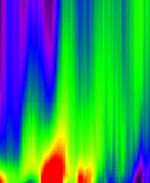
Image credit: Cornell
An instrument on the NASA rover Spirit in Gusev crater on the surface of Mars has detected billows of warm air — called thermals — which rise from the planet’s surface into the thin atmosphere. Thermal changes create wind, and this was the first time these pockets of warm air have been detected on the planet.
“We now can see them (thermals) on Mars and learn how quickly they rise, giving us a better understanding of the wind dynamics there,” said Donald Banfield, Cornell senior research associate in space sciences, at a press briefing today (Feb. 12) at the Jet Propulsion Laboratory in Pasadena, Calif.
Atmospheric science is critical to understanding the complete Martian environment, explained Banfield. Before this mission, planetary scientists had scarce information on the planet’s surface-temperature structure. Satellites orbiting Mars provided temperature information for the upper portions of the planet’s atmosphere. Until now, the temperatures on the surface could not be measured.
Banfield said that wind is sculpting the geological features on Mars. “Wind is the issue. It creates dunes, dust devils and dust storms, and understanding it is important,” he said.
Before the rover Spirit experienced memory malfunctions in January, its Mini-Thermal Emission Spectrometer device, or MiniTES, gathered one eight-minute block of spectral data by staring at the Martian sky. The data, examined by Michael Smith of NASA’s Goddard Space Flight Center and Banfield, showed pockets of warm air rising every few minutes. Both are members of the Mars Exploration Rover mission’s science team.
The MiniTES instrument can read the temperature by analyzing the infrared spectrum in the lower atmosphere. Banfield explained that since the Martian atmosphere is mostly carbon dioxide, the instrument perceives the infrared light wavelength and translates it into temperature.
“We saw warmer and cooler places in the Mars atmosphere,” Banfield told the media. “There were warm blobs and cold blobs passing over the rover.”
As the sun rises each day on Mars, the surface temperature climbs much like on Earth. “There is an upward trend of warm air, convection,” said Banfield. “This is exciting data?this is novel data.”
Meanwhile on the other side of Mars, the rover Opportunity, now at the rock outcrop Stone Mountain on the Meridiani plain, obtained an extreme close-up of round, blueberry-shaped formations in the soil. The spherically shaped formations are about the size of BB pellets and the mission scientists have begun to study them for clues about the soil’s development.
Original Source: Cornell News Release
